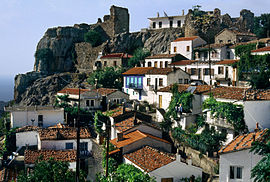Samothraki
|
Samothrace Σαμοθράκη |
|
|---|---|

View of the Chora (Samothraki)
|
|
| Coordinates: 40°29′N 25°31′E / 40.483°N 25.517°ECoordinates: 40°29′N 25°31′E / 40.483°N 25.517°E | |
| Country | Greece |
| Administrative region | East Macedonia and Thrace |
| Regional unit | Evros |
| Area | |
| • Municipality | 178.0 km2 (68.7 sq mi) |
| Highest elevation | 1,611 m (5,285 ft) |
| Lowest elevation | 0 m (0 ft) |
| Population (2011) | |
| • Municipality | 2,859 |
| • Municipality density | 16/km2 (42/sq mi) |
| Time zone | EET (UTC+2) |
| • Summer (DST) | EEST (UTC+3) |
| Postal code | 680 02 |
| Area code(s) | 25510 |
| Vehicle registration | ΕΒ |
| Website | www.samothraki.gr |
Samothrace (also Samothraki) (Greek: Σαμοθράκη, [samoˈθraci]) is a Greek island in the northern Aegean Sea. It is a municipality within the Evros regional unit of Thrace. The island is 17 km (11 mi) long and is 178 km2 (69 sq mi) in size and has a population of 2,859 (2011 census). Its main industries are fishing and tourism. Resources on the island include granite and basalt. Samothrace is one of the most rugged Greek islands, with Mt. Saos and its tip Fengari rising to 1,611 m.
Samothrace was not a state of any political significance in ancient Greece, since it has no natural harbour and most of the island is too mountainous for cultivation: Mount Fengari (literally 'Mt. Moon') rises to 1,611 m (5,285 ft). It was, however, the home of the Sanctuary of the Great Gods, site of important Hellenic and pre-Hellenic religious ceremonies. Among those who visited this shrine to be initiated into the island cult were Lysander of Sparta, Philip II of Macedon and Lucius Calpurnius Piso Caesoninus, father-in-law of Julius Caesar.
The ancient city, the ruins of which are called Palaeopoli ("old city"), was situated on the north coast. Considerable remains still exist of the ancient walls, which were built in massive Cyclopean style, as well as of the Sanctuary of the Great Gods, where mysterious rites (Samothracian Mysteries) took place which were open to both slaves and free people (similar to the Eleusinian Mysteries). Demetrios of Skepsis mention the Samothracian Mysteries.
...
Wikipedia


